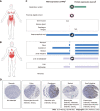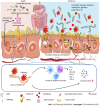Mechanism and potential treatments for gastrointestinal dysfunction in patients with COVID-19
- PMID: 36632313
- PMCID: PMC9827583
- DOI: 10.3748/wjg.v28.i48.6811
Mechanism and potential treatments for gastrointestinal dysfunction in patients with COVID-19
Abstract
The global coronavirus disease 2019 (COVID-19) has become one of the biggest threats to the world since 2019. The respiratory and gastrointestinal tracts are the main targets for severe acute respiratory syndrome coronavirus 2 infection for they highly express angiotensin-converting enzyme-2 and transmembrane protease serine 2. In patients suffering from COVID-19, gastrointestinal symptoms have ranged from 12% to 61%. Anorexia, nausea and/or vomiting, diarrhea, and abdominal pain are considered to be the main gastrointestinal symptoms of COVID-19. It has been reported that the direct damage of intestinal mucosal epithelial cells, malnutrition, and intestinal flora disorders are involved in COVID-19. However, the underlying mechanisms remain unclear. Thus, in this study, we reviewed and discussed the correlated mechanisms that cause gastrointestinal symptoms in order to help to develop the treatment strategy and build an appropriate guideline for medical workers.
Keywords: Angiotensin-converting enzyme-2; COVID-19; Gastrointestinal symptom; Intestinal barrier permeability; Mechanism; Transmembrane protease serine 2.
©The Author(s) 2022. Published by Baishideng Publishing Group Inc. All rights reserved.
Conflict of interest statement
Conflict-of-interest statement: All the authors report no relevant conflicts of interest for this article.
Figures





Similar articles
-
Current understanding of the impact of COVID-19 on gastrointestinal disease: Challenges and openings.World J Gastroenterol. 2021 Feb 14;27(6):449-469. doi: 10.3748/wjg.v27.i6.449. World J Gastroenterol. 2021. PMID: 33642821 Free PMC article. Review.
-
Gastrointestinal coronavirus disease 2019: epidemiology, clinical features, pathogenesis, prevention, and management.Expert Rev Gastroenterol Hepatol. 2021 Jan;15(1):41-50. doi: 10.1080/17474124.2020.1821653. Epub 2020 Nov 24. Expert Rev Gastroenterol Hepatol. 2021. PMID: 32955375 Review.
-
COVID-19, nausea, and vomiting.J Gastroenterol Hepatol. 2021 Mar;36(3):646-656. doi: 10.1111/jgh.15261. Epub 2020 Oct 5. J Gastroenterol Hepatol. 2021. PMID: 32955126 Free PMC article. Review.
-
The roles of nausea and vomiting in COVID-19: did we miss something?J Microbiol Immunol Infect. 2021 Aug;54(4):541-546. doi: 10.1016/j.jmii.2020.10.005. Epub 2020 Oct 17. J Microbiol Immunol Infect. 2021. PMID: 34435559 Free PMC article. Review.
-
Clinical Characteristics of COVID-19 Patients With Gastrointestinal Symptoms in Northern Italy: A Single-Center Cohort Study.Am J Gastroenterol. 2021 Feb 1;116(2):306-310. doi: 10.14309/ajg.0000000000000965. Am J Gastroenterol. 2021. PMID: 33009054
Cited by
-
Creating a Vaccine-like Supplement against Respiratory Infection Using Recombinant Bacillus subtilis Spores Expressing SARS-CoV-2 Spike Protein with Natural Products.Molecules. 2023 Jun 26;28(13):4996. doi: 10.3390/molecules28134996. Molecules. 2023. PMID: 37446658 Free PMC article.
-
Revolutionizing Gastrointestinal Disorder Management: Cutting-Edge Advances and Future Prospects.J Clin Med. 2024 Jul 8;13(13):3977. doi: 10.3390/jcm13133977. J Clin Med. 2024. PMID: 38999541 Free PMC article. Review.
-
Gastrointestinal symptoms in COVID-19 and disease severity: a Japanese registry-based retrospective cohort study.J Gastroenterol. 2024 Mar;59(3):195-208. doi: 10.1007/s00535-023-02071-x. Epub 2024 Jan 25. J Gastroenterol. 2024. PMID: 38270615
-
Precut mucosectomy versus endoscopic resection techniques for colorectal lesions sized 10-30 mm: meta-analysis and systematic review.Surg Endosc. 2025 Jul 21. doi: 10.1007/s00464-025-11981-1. Online ahead of print. Surg Endosc. 2025. PMID: 40691336 Review.
References
-
- Cao B, Wang Y, Wen D, Liu W, Wang J, Fan G, Ruan L, Song B, Cai Y, Wei M, Li X, Xia J, Chen N, Xiang J, Yu T, Bai T, Xie X, Zhang L, Li C, Yuan Y, Chen H, Li H, Huang H, Tu S, Gong F, Liu Y, Wei Y, Dong C, Zhou F, Gu X, Xu J, Liu Z, Zhang Y, Shang L, Wang K, Li K, Zhou X, Dong X, Qu Z, Lu S, Hu X, Ruan S, Luo S, Wu J, Peng L, Cheng F, Pan L, Zou J, Jia C, Liu X, Wang S, Wu X, Ge Q, He J, Zhan H, Qiu F, Guo L, Huang C, Jaki T, Hayden FG, Horby PW, Zhang D, Wang C. A Trial of Lopinavir-Ritonavir in Adults Hospitalized with Severe Covid-19. N Engl J Med. 2020;382:1787–1799. - PMC - PubMed
-
- Mao R, Qiu Y, He JS, Tan JY, Li XH, Liang J, Shen J, Zhu LR, Chen Y, Iacucci M, Ng SC, Ghosh S, Chen MH. Manifestations and prognosis of gastrointestinal and liver involvement in patients with COVID-19: a systematic review and meta-analysis. Lancet Gastroenterol Hepatol. 2020;5:667–678. - PMC - PubMed
-
- Pan L, Mu M, Yang P, Sun Y, Wang R, Yan J, Li P, Hu B, Wang J, Hu C, Jin Y, Niu X, Ping R, Du Y, Li T, Xu G, Hu Q, Tu L. Clinical Characteristics of COVID-19 Patients With Digestive Symptoms in Hubei, China: A Descriptive, Cross-Sectional, Multicenter Study. Am J Gastroenterol. 2020;115:766–773. - PMC - PubMed
-
- Redd WD, Zhou JC, Hathorn KE, McCarty TR, Bazarbashi AN, Thompson CC, Shen L, Chan WW. Prevalence and Characteristics of Gastrointestinal Symptoms in Patients With Severe Acute Respiratory Syndrome Coronavirus 2 Infection in the United States: A Multicenter Cohort Study. Gastroenterology. 2020;159:765–767.e2. - PMC - PubMed
-
- Wu C, Chen X, Cai Y, Xia J, Zhou X, Xu S, Huang H, Zhang L, Du C, Zhang Y, Song J, Wang S, Chao Y, Yang Z, Xu J, Chen D, Xiong W, Xu L, Zhou F, Jiang J, Bai C, Zheng J, Song Y. Risk Factors Associated With Acute Respiratory Distress Syndrome and Death in Patients With Coronavirus Disease 2019 Pneumonia in Wuhan, China. JAMA Intern Med. 2020;180:934–943. - PMC - PubMed
Publication types
MeSH terms
LinkOut - more resources
Full Text Sources
Medical

